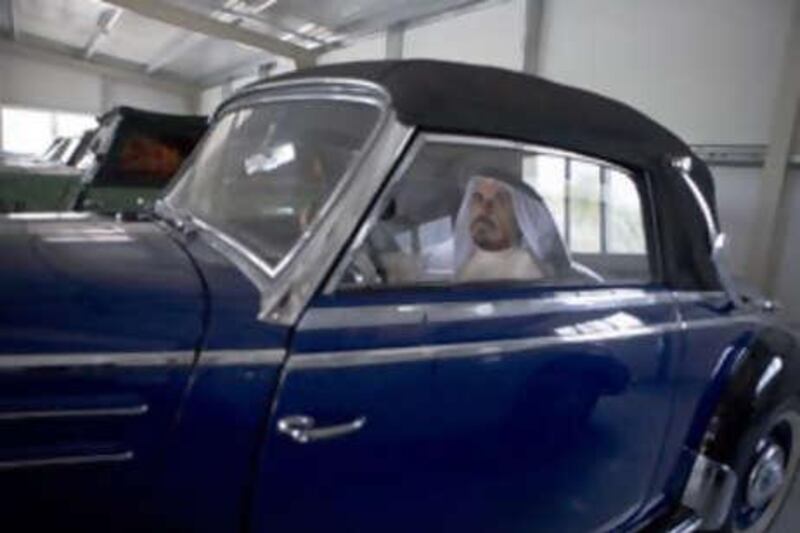When Mohammed al Fahim was born, the UAE was still a collection of warring tribes, so isolated from the modern world that only a lucky Sheikh could afford to drive a second-hand car. Today, the flashy Ferraris and Jaguars that zoom up and down the smooth roads linking the seven Emirates are as ubiquitous as the towers rising in the desert. And Fahim, perhaps more than most, appreciates a good car. The Abu Dhabi resident and honorary chairman of the Al Fahim Group has a collection of 48 antique vehicles for which he has just built two hangars at his farm outside the capital.
"We didn't have electricity or radios or cars or anything when I was younger. Because we missed out on all these things, I want to collect them," says Fahim as he drives his silver Mercedes 4X4 to the date palm farm in Al Bahia. "And here we are at the car farm," he says, pulling up to the driveway. The narrow road leading to the hangars is lined with banana and mango trees. Several hundred metres from the main gate are the two buildings opposite each other. The first is used mainly for maintenance, the second, where we stop, houses most of the cars. The vast room is climate-controlled and the ceiling is low. Two rows of gleaming vehicles, all models dating from 1913 to 1960, face each other.
"I like older cars," he says, wiping a smudge of dust off the bonnet of a maroon Jaguar. "They are more stylish and more decorative, more classic. After 1960 I stop because they are not very classic. The 1950s I love because they have a lot of chrome. I love cars with chrome." Some carry special memories, such as the 1948 Pontiac Buick with pine doors and a roomy wooden interior that resembles a log cabin.
"I call this Woody. I used to take the children to school in it," says the father of eight. He travels all over the world to buy cars including France, Portugal, America and England and pores over car magazines to find out the latest news about upcoming shows. Each car in his collection is part of his history, including a pair of red and green 1913 Morris-Oxfords which he bought in Wales for £25,000 (Dh183,000) each, 20 years ago. A crank in front of the bonnet starts the engine and the petrol is stored next to the driver's seat in a large, exposed, square tank.
Fahim, 59, was born in Muwayje near Al Ain. In those days, travel between the oasis town and Abu Dhabi was a seven-day trek by camel. People rarely ventured outside their sheikhdom because intertribal warfare and the heat made journeys too dangerous. His father was one of the few people who could read and write and because of this Sheikh Zayed made him an advisor. "Sheikh Zayed told my father to go and import cars. They were doing it in Dubai and Bahrain so we should too," he says. When the business began, the vehicles were off-loaded from freights onto a barge about three or four kilometres offshore. Then they were tugged by boat to a beach and driven off wooden ramps set up on the sides of the vessel. As Fahim supervised all this, customers waiting on the shore approached him with a price. After some haggling, a wad of cash was exchanged for a set of keys and the new owner drove off. There was no paperwork. Today, the family business has contracts to import Mercedes-Benz, Fiat and Chrysler.
Fahim got his first car, a Chevrolet Impala, when he was 18. Unfortunately, he says, he doesn't have it anymore. "I felt like a king taking my friends for a ride. They were jealous." In the 1960s there were few roads and drivers had to swerve quickly to avoid getting stuck in the sand. The dark army-green 1952 Land Rover parked in the hangar, made in Solihull, England, was typical of what Abu Dhabi inhabitants drove at the time.
"This is the type Sheikh Zayed used to drive," he says. "It's a four-wheel drive, four-cylinder. It didn't even have a key. You could press down the knob and the car started. You had to be a rich man to drive this." The most unusual vehicle Fahim owns is the German-made amphibious Amphicar, a red 1964 model that can travel at a top speed of 11 kilometres per hour in the water because of the twin nylon propellers in the undercarriage. Only a few thousand were ever made.
"I used to go fishing with this car in shallow water," he says. Widely regarded as an authority figure on the history of Abu Dhabi, Fahim's first-hand account of the transformation of the city into a glittering and modern city state is recorded in his book, From Rags to Riches: A Story of Abu Dhabi. One of the most potent symbols of that transformation was the arrival of the car. "Without the car Abu Dhabi would not have developed," he says. "Abu Dhabi had oil fields in the western region, 400 kilometres away, the agricultural lands were 100 kilometres away and the fishing ports were another 100 kilometres away. Cars were instrumental."
He says he wrote the book to preserve local history and teach his children that life was not always easy. "We had to work very hard, we suffered. We didn't get things on a golden spoon," he says. He continues: "The level of satisfaction has changed. In my days owning a bike was a treat. Now my sons want supercharged cars. I have a four-year-old grandson. And if I ask what he wants he says 'a Lamborghini or a Ferrari?'"






